a literary journal published by the Black Earth Institute dedicated to re-forging the links between art and spirit, earth and society
Some twenty or so years later, in 2010, I received a grant to study the Rust Belt. I was living in West Virginia at the time and taking impromptu road trips to industrial cities. The Rust Belt is a sort of nickname given for the cities of major industry in America. Those cities include but are not limited to Paterson, New Jersey, Detroit, Akron, Youngstown, Cleveland, Pittsburgh, Weirton, Baltimore, Gary, Indiana; Buffalo, and Bethlehem, Pennsylvania.
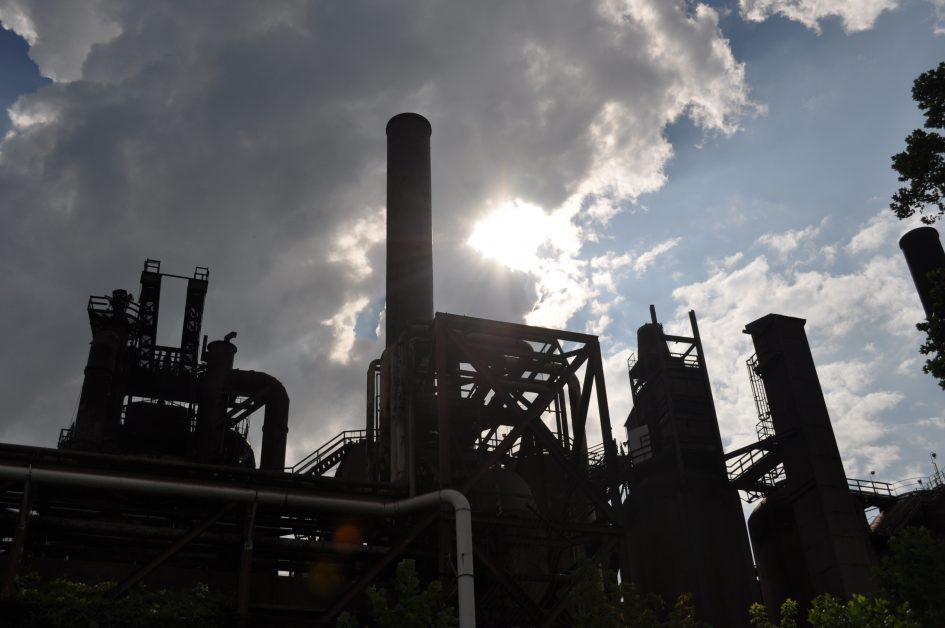
KP Giordano – ArcelorMittal is a foreign-based steel company that bought up Bethlehem Steel when that company went bankrupt. This ArcelorMittal plant in Weirton, West Virginia is sitting unused and surrounded by overgrown weeds and garbage.
When I started visiting some of these cities, my childhood memories of hanging at my father’s plumbing shop came back to me and I became enamored and spellbound all over again. I began to luxuriate in the hopelessness of these places: again, the same delicacies: empty warehouses, abandoned steel plants, dirty rivers, rail road tracks, and rubble. Once again I become a kid, playing around in it all.
My father got a kick out of what I was doing and was especially interested in Detroit. But he didn’t have the same love for post-industrialism as I did. He saw it for what it was. A means to an end. His thinking went along these lines: A warehouse is a place to make widgets. We need widgets. And he’d ask me in not so many words. Why are you staring at the warehouse? Stare at the widgets. And there was our dilemma. I had always been fascinated with the means, whereas he was fascinated with the ends. But the means were now falling apart and I wanted to go photograph them.
I started in Buffalo. The waterfront by Lake Erie reminded me of the Jersey Shore: sleepy, moody, trashy. There were wind turbines–about a half dozen–situated on or near the land of the former Lackawanna Steel Company, a subsidiary of Bethlehem Steel. Across the street from this one beach area was Bethlehem Park, near the Old First Ward. The Lackawanna/Bethlehem Steel site was fenced off; only a few buildings still left standing.
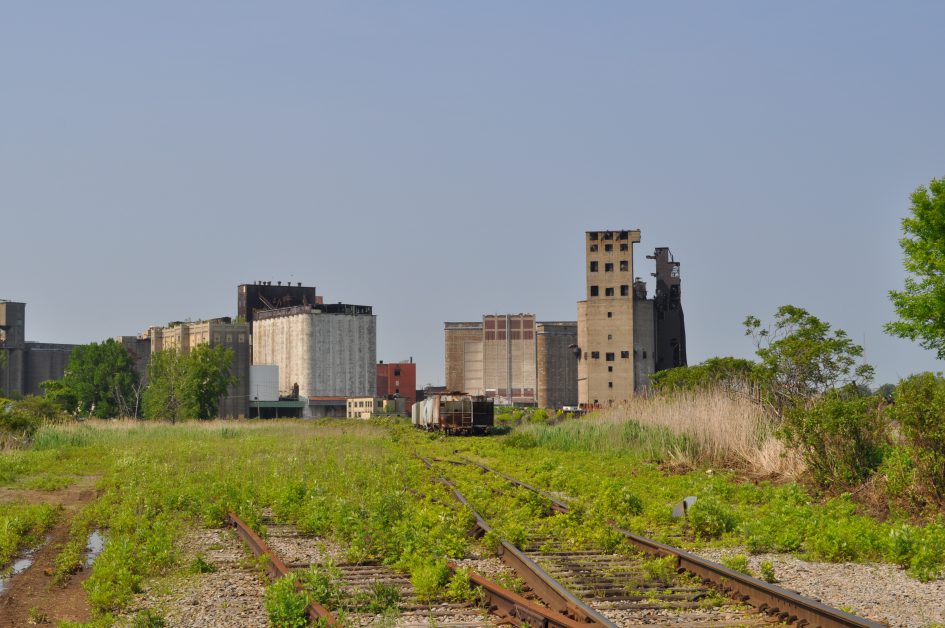
KP Giordano – Buffalo, New York, facing east. Former area for grain elevators, it is now a home for nothing but junkyards. Lake Erie is walking distance in the opposite direction.
All this moody dilapidation! I spent a few hours on Route 5, photographing grain elevators and empty factories. Bethlehem Park, a former steel worker housing enclave, is now home for lower middle class families. I wound myself into the Old First Ward, site of much of the former industry, now worn down and abandoned with only some scrap metal businesses left. Later in the day I visited the inside of a grain elevator, a dangerous move, especially alone, but I felt comforted that it was about three in the afternoon. I followed the Buffalo River nostalgically, like a little kid, and even looked for oil slicks. I recalled Jack London, who was here as a young man, who, having just gotten off a rail car, came to Buffalo for work, but only ended up broke, arrested for vagrancy, and thrown in jail. He managed to flee Buffalo the same way he came, on a freight train.
All along I was thinking of my father and my grandfather, who started the family business, a business that I never became a part of, probably for lack of ability and also lack of interest. Maybe I was feeling guilty for not having joined the business and contributed somehow. Or maybe I felt I had failed my father. There is, and was, something to all of it, but what I think was at the heart of my interest in the Rust Belt was history and loss. Things of the past had always intrigued me, and things of the past that were dilapidated and of no use were even more intriguing. Maybe they are one and the same. Maybe history and loss are synonymous.
Pittsburgh by far was the least worn down of the cities. So much of the former steel industry here is gone—absolutely nonexistent—but the downtown remains intact and charming. Heading farther south though is where there are still some industry and fall out areas, places like the towns of Clairton and Braddock, where there is poverty, low income housing, and abandoned industrial sites. It’s around here that the movie The Deer Hunter was filmed. These two small towns have not quite rebounded from the fall of the steel industry. However, U.S. Steel is still running. You may have seen the famous two-story statue of the bulky steel worker man bending a piece of iron. But even at U.S. Steel, it is as quiet as Sunday afternoon in the middle of the week. I imagine a lot of people used to walk from their little two-room company hovels to this enormous plant years ago, but now it’s a ghost town.
Being around Pittsburgh and these former sites I started to understand American patriotism in a different way. Immigrants a century ago thought of American streets as lined with gold because of places like Pittsburgh, where the steel industry provided jobs and people saw so much promise. Abundance and prosperity. I still sensed that in the air. I attributed it to the location too, in Appalachia but on the edge of the frontier. This was the sort of liftoff point, the edge of the start of the west.
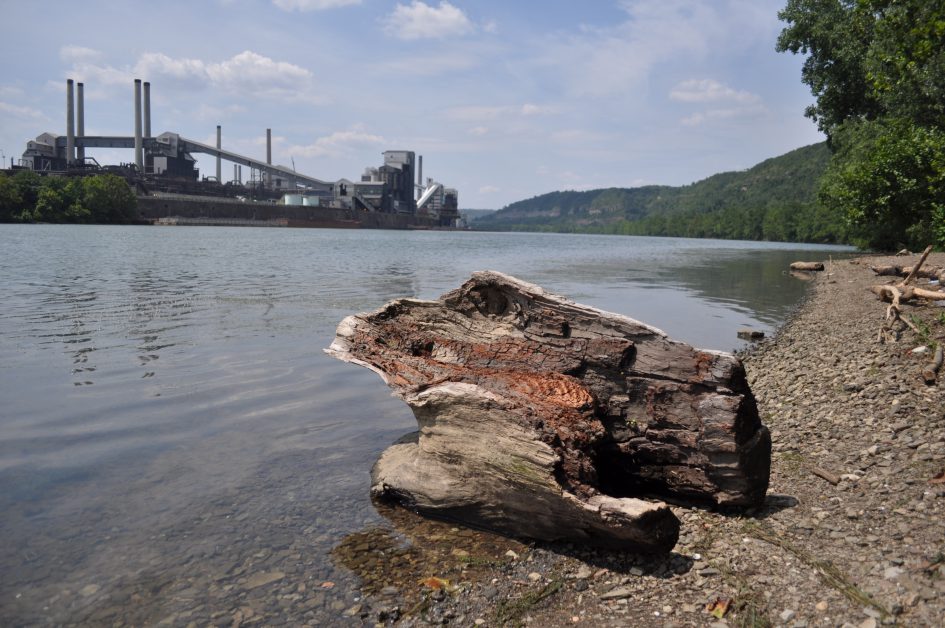
KP Giordano – Wood was once used to fire the blast furnaces, later replaced by coal. This piece of wood sits on the banks of the Monongahela River in the suburbs of Pittsburgh. U.S. Steel is in the background upriver heading north.
My trips to Pittsburgh coincided with my trip to Weirton, West Virginia, no more than an hour west of Pittsburgh, once a major seat of steel making. It now has a good sized ArcelorMittal plant in active operation. But having met with a manager at one of the sites, I found that this steel plant, not to mention possible others, end up becoming fronts for no business at all. ArcelorMittal and following them, Severstal, have bought up U.S. steel manufacturing companies and left them to sit. At one site in Weirton and also on the Ohio side, near the towns of Follansbee and Mingo, some former steel plants are rotting, owned by these new companies but are not producing anything. I was told that some 300 people work at these plants, mostly sifting through scrap metal to be used or shipped to working steel plants. This is what has happened with the foreign-owned steel companies and American steel companies. There was a lot of decay in Weirton, especially near the ArcelorMittal plant. This was the only site that I was actually chased off of by security. I’d been snapping photographs for a few hours when they caught up with me.
I’m hardly the first voyeur of ruined American cities. Writers and artists have been capturing these locales for decades. In Detroit, a genre has been created, called “Ruin Porn,” the name given to photographs such as the ones I was taking. Ruined places that demand we look at them, even when we resist, because they are beautiful as well as disturbing.
Unfortunately, The Rust Belt is not a historical picture postcard to be photographed in black and white and remembered nostalgically. It’s clear proof of why our economy is what it is today. I equated these ruined former industrial cities with the Egyptian ruins, signs of a lost civilization. Ours. We are not the same manufacturing country we once were. The independent country that Alexander Hamilton had envisioned is gone. Silicon Valley did not end up providing thousands of jobs for people in the Midwest. But this was what I had to learn. Because I went into this project with the mind of a child, the same mind I had when I played at my father’s shop as a boy, it was going through this that made me, or at least that part of me, grow up.
Detroit is by far the city in most disrepair. Joel Stone, a member of the Detroit Historical Society, suggested that I don’t go to the famous Packard Automotive Plant unless it’s in the middle of the day and I have fifteen people with me who are each the size of a football player. A quarter mile of broken brick and concrete, the Packard Plant is a small city of devastation. I did choose the middle of the day, a sweltering ninety degree afternoon, but I went alone. The huge ten-story brick buildings are formed into an what now looks like an old prison fortress. Once inside through broken fencing, you see piles of concrete and broken glass, broken windows, old fabric curtains flapping in the breeze, doorways with nothing but concrete and hinges, and black holes everywhere. Fortunately, this major American eyesore and symbol of Detroit’s bankruptcy is slated to be razed sometime in 2012 or early 2013.
Another dilapidated area is near The Piquette Plant where Henry Ford first started his car manufacturing business. The small building now holds a modest Ford museum. Some of the first built cars by Ford sit in the parking lot, rather lonesome in the noonday sun, as though they were pulled in that morning and parked haphazardly. I don’t think they get many visitors considering the rundown area is a cavern of empty warehouses. Some artists have taken up in the buildings, however. Some warehouses have been renovated, but there is a overall sense of isolation and loneliness. Odd, since the day I arrived was a beautiful summer’s day.
More hope can be found in Detroit’s Severstal plant. This steel maker was a child of ArcelorMittal and, before that, Bethlehem Steel. Ford has its “Rouge” Plant next door to the Severstal Plant and the entire area, what the locals call the industrial sector, looks rather vibrant. The Ford plant is surrounded by rich foliage, flowers, trees and shrubs, making it look more like a credit card corporate building then a car manufacturer. Meanwhile, Michigan Central Station held me captivated, as it has many others. This edifice of a train depot mirrors Grand Central Station but is twice the size. It is now gutted, but still makes for a riveting view. Some renovation is underway.
Cleveland’s dilapidation seems far less, which was a surprise, since I’d heard the city had a lot of abandoned buildings and urban decay. Two factors seemed to show the city’s promise. First, ArcelorMittal has located its main headquarters in Cleveland. There is a lot of activity in steel production and therefore the industrial area. Second, the old steel plants and industrialized zone have been turned into a mini mall area called Industrial Valley. Cleveland has opted to pay homage to its once industrial environs by calling attention to the steel industry through use of the name and creating steel-industry themed restaurants. So American. They are also building a small museum out of a former bank that steel workers used. An unused set of train tracks are being used to hold a “bottle car,” once used to carry molten steel. There are plaques and walkways for people to visit. This area is tiny, but it is a start, and the area, with its Verizon store and name brand outlets, attracts people. The parking lot provides a nice view of the former industrial site and the back end of the still working site of ArcelorMittal.
In this weakened state, mine and the country’s, I made an effort to reach out to my father, to bridge the gap of generations, caused, perhaps, by my never having become an industrial worker of any kind and not having joined the family business. I was getting my politics straight. Equalizing. Neutralizing. Maybe I was bridging a gap within myself, drawing a bridge over that waste-strewn, oil-soaked river. Or maybe it had nothing to do with my father. Maybe my father was a symbol. Maybe I was working out my own confusions and failures through that symbol. But I was sure of one thing. I wanted to put something together again, make it whole—by studying things that were completely decimated and lying in pieces.
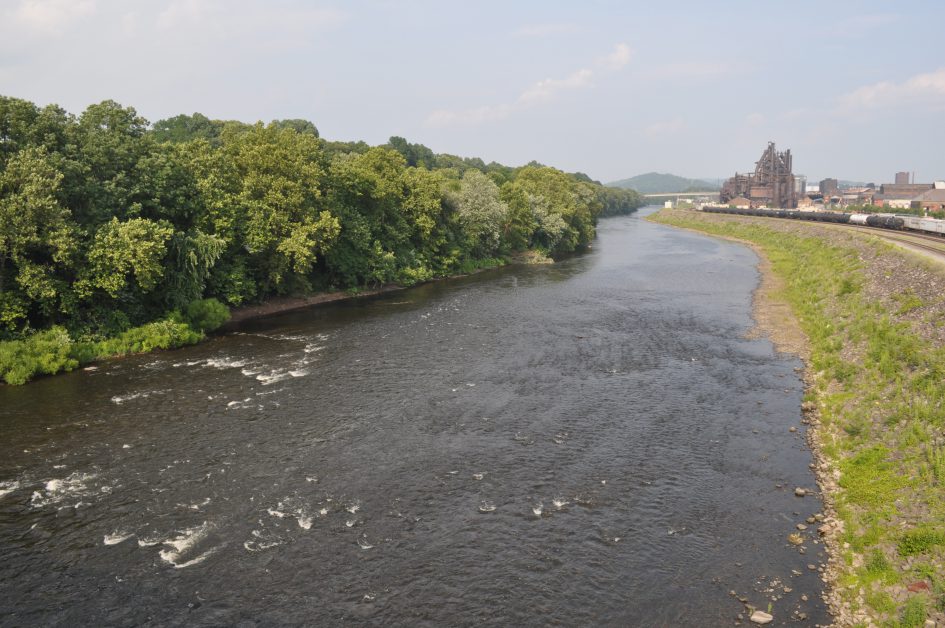
KP Giordano – Rivers were an integral part of the steel making business. Millions of gallons of water were used in the process, not to mention shipping. This is Lehigh River in Bethlehem, Pennsylvania, with Bethlehem Steel plan in the far background.
I had heard the song “Youngstown” by Bruce Springsteen and so I had some things in mind when I drove to Youngstown, Ohio. The downtown area was somewhat vacant. It looked a little like a 1950s noir film, a small sleepy main street with stores that on Saturday afternoon were mostly closed. Little traffic, some young people. I noticed more drug addicts walking around and nodding out than anything else. However, Youngstown State University brought some college vibrancy to the area. Yet on side streets I noticed those old brick buildings so representative of the 1930s.
I focused on Youngstown Sheet & Tube. Through the help of one of the city historical archivists, I was able to penetrate into one of the old neighborhoods where Youngstown Sheet & Tube housed its workers. A few of the original buildings were still standing. What I found first was the old hospital built by Youngstown Sheet & Tube for its workers, now on the property of a bridge paint company. The owner found me photographing from under an abandoned tractor trailer. He was kind enough to let me behind the chain link fence. The hospital, a yellow stone building no bigger than a block wide, is in serious dilapidation but is inhabitable. The bridge paint company is using it as storage. The owner admitted to not knowing the significance of the building and also of never having visited the third floor. While the rooms were a bit spooky, the third floor was the most intact. Some of the sinks and doors were an antique collector’s dream. Nothing, it seemed, had been touched since people left. It seemed like people simply abandoned the place, left it standing and walked away.
Up the road, at the Settlement Housing built by Youngstown Sheet & Tube, a sign reads U.S. Historical Site, 1918. Next to it and all around it, squalor abounds. Again, without the help of my archivist friend, I may not have been able to find this location or enter into it. A few of the locals tried to chase me off the property but the archivist talked them out of it. These people were not renters but squatters. The extreme poverty and decay was palpable. The area had been marked for being razed. Meanwhile, residents, went about their business. There didn’t seem to be crime, but rather extreme poverty. One of the residents claimed to have owned a few of the apartments and was in the process of renovating them. I’m not sure how true this is or was. I’m not sure who owns this property or who is even interested. Not even the archivists knew exactly what the city was planning to do with the property, if anything.
I think that Springsteen and many others artists have captured some of America’s pining and wistful nostalgia for the industrial era. Throughout my trip I had feelings that went to both these spectrums, moments of nostalgia and moments of hope, or a sense of reality and the future. I saw in my relationship with my father the feeling of things that were past, that his years in business, his way of living was nostalgic. Those old days of working for a company all your life, getting retirement pension, raising a family, I’m not sure if they still exist as they once did. It’s sad and realistic at the same time. Also those ideas that the next generation must do better than the last–how much better? Three cars instead of two? Five children instead of three? What is growth and prosperity and abundance? Is it in money and material objects?
My next trip was to Bethlehem, Pennsylvania, original home of Bethlehem Steel. It is only an hour and a half from New York City and the same distance to the New Jersey beaches, but feels in the middle of nowhere. Only the Lehigh River going through it could explain why it was situated there. But of all the locations, Bethlehem had the most preserved steel mill location. The actual blast furnaces are perfectly intact, and many of the warehouses where objects were fashioned out of the steel are still up and standing. There are not a lot of broken windows or piles of rubble. It has been cleared and swept and though the warehouses are abandoned, a look inside reveals many of the old machinery used to create everything from engines to kitchen sinks to nails and tools.
Like Cleveland, Bethlehem has embraced its history. There is a coffee shop and restaurant and general social area for outdoor concerts right on the site of the Bethlehem Steel Plant. The smaller buildings of Bethlehem are being used by new and local companies and the actual entrance way to the plant is still intact. Many enormous steel-making products are sitting about as historical items posing as sculptures. There is an arty feel to the area, like one big post-modern art museum rather than a historical site, or dare I say, an abandoned steel-making plant.
I convinced my father to meet me in Bethlehem. As it turned out, he wasn’t all that interested in seeing the steel plant. He was interested in gambling, and Bethlehem Steel’s location also houses a Sands Casino. Inside it looks like Las Vegas and there are several restaurants inside. Save a city, build a casino.
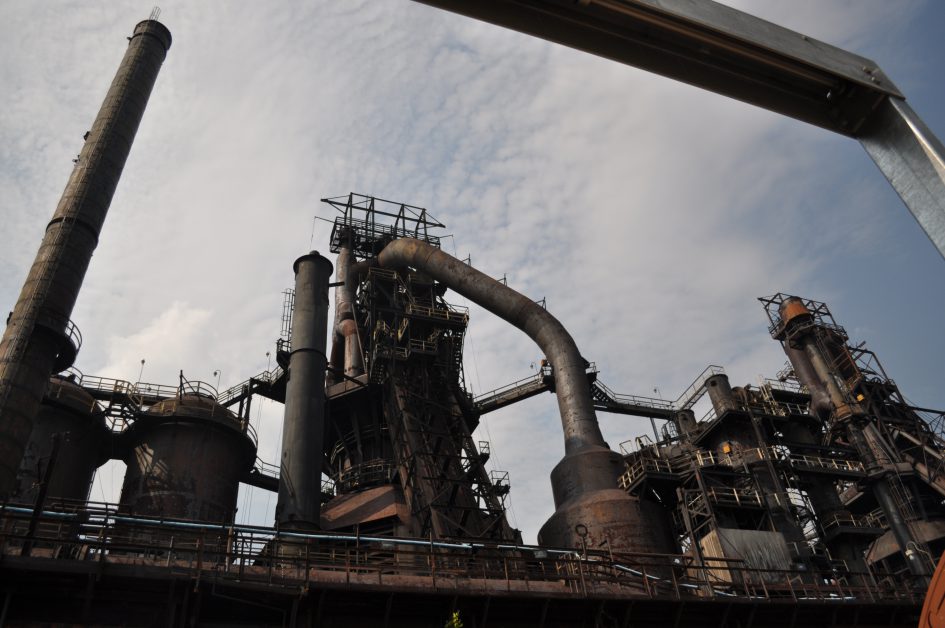
During this time, my father and I talked a lot about “the way it was” in the turn of the century and industrialism. We are not falling apart, I said, we already have. We are now in the aftermath, short of pure Armageddon. There’s not much to say after that. There was something sad I think in that my father had worked in that sort of sector of industrialism, and if that didn’t matter, if we had failed, if the country had shipped the jobs out, if it was the end, then isn’t it in the end for him too? And what do we have left? What I arrived at was a better relationship with my father. Had I been looking for this all along, I might have gone a different route, but I wasn’t sure this was what I was after. Maybe some time together, some fun. But this was the result. I secretly in my heart of hearts knew that this post-industrial crusade I was on would somehow how link me with my father, with my family, with my upbringing. I have long since stopped feeling guilty about the career I had chosen. So having no guilt for that, I sought to bridge the gap some other way.
It was just after my Bethlehem trip that I made my way to Paterson, New Jersey. The Paterson Cultural and Historical building is catty-corner to the Paterson falls, on the corner of McBride and Spruce Street. Alexander Hamilton, sometimes called the father of American industrialism, imagined this corner as the cornerstone of the first industrialized planned city. Down the block is a Burger King. But behind the Burger King is the lower and upper raceways. The terms raceway meant the canals that were built to divert the water from the Paterson falls into the turbines or use the water to turn the turbines.
The graffiti is more prevalent here than in Buffalo. Everything seems to have some kind of graffiti tag, most annoying when you are trying to read some of the plaques. Alexander Hamilton had been a great admirer of art. He had his own collection of paintings which he had purchased on trips to England. His wife was an equally great admirer. I wonder if Hamilton would admire the graffiti here.
I was referred to what some here have called humorously the Valley of the Rocks. This is an area that is just behind Market Street and rather hidden but no less scary, something like Detroit’s decimated neighborhoods. The so-called Valley of the Rocks is just behind many of the now historical textile mills. But more of the old mills are now in rubble. I had to sneak in, crawl through a fence. Immense boilers turned over, brick walls standing alone, twisted steel and iron beams jutting into the air, smoke stacks and water towers barely standing. I found broken beer bottles and some hypodermic needles on a piece of stone that may have been from the 18th century. There was hope though. Outside the fenced gate was a plan by the city to renovate the area.
There was also a lot of political talk during the Republican debates between Romney, Gingrich, Santorum, Paul, etc, as well as the state of the economy. How far we had come as a country? The unequal distribution of wealth. I had argued with my father about capitalism. Though I may have seemed idealistic, my political beliefs were always mixed, but I had seen what my father hadn’t seen yet: that the end had already arrived and as a result, America was in a recession. It wasn’t getting bad, it had already gotten bad. I argued that the country was in this situation because these cities had been abandoned, that industrialism was gone from the U.S. We weren’t making things anymore. Someone else in another country was, such as China, and they were providing jobs to their millions of people. And that half of our country was paying for the unemployed, through unemployment and/or aid programs. The welfare state. We had gone from capitalism, to extreme capitalism, to socialism. Or at least we were heading that way. So much of what I saw in the Rust Belt was simply not indicative of what America looked like to people in New York or Los Angeles. The middle of America was impoverished, drawing on the federal and state government to pay for them. The middle was in fact blown out. The U.S. may never see as much growth in terms of industry as it did when Hamilton had first imagined it.
During the Paterson trip, I made sure to see my folks, and I invited my father on some of the excursions. That summer my father and I enjoyed some baseball games together, namely the Derek Jeter Yankee game where he hit 3,000 home runs. A major feat in baseball. We drove back to those neighborhoods, where the business was in northeast New Jersey.
My father took over the family business in the early 1970s when his father died. My grandfather had started it before the second world war. My father, with his brothers, had continued building it up into a prosperous company. My mother and aunt worked there, and on some Saturdays I went to the shop to sell kerosene. After high school, I had a short stint working as a plumber’s apprentice. There was a short period there when I had wished I had become a plumber and worked in the family business, but seeing that I was extremely non adept at all things involving tools and mechanics, I didn’t have a chance. Or maybe I didn’t want a chance. As it turned out, my father bought out of the business in the late 1980s, and took to semi-retirement.
On our drive to northeast New Jersey, my father pointed out some sites, like where my grandfather had once picked up equipment or went to a warehouse for something, or the roads they drove to get here or there. We wound our way back to the old office site on the Hackensack River, in Ridgefield Park, where I played as a boy and he worked. We tried to go into the old office, but no one was. Then he went to the junkyard next door, introducing himself and asking if the owner was around. A young girl said no but would make a call. I walked to the same place where I played as a boy on the Hackensack River. I was surprised at how clean it was. It looked like any old river. Maybe progress had been made. Maybe the reduction of industrialism was bringing back the environment.
At this moment, I think, that I became at peace with everything I’d been after on this trip. I think that seeing my father walking around slightly lost and discouraged by what had become of his old business haunts, not to mention the whole country, put us both on the same page. I had made a sped-up version of living industrialism to his having worked in it. I had ostensibly become a plumber, in my own way, in the way that I experience things, and so we had lived through the same things and seen the end of it.
I had promised my father dinner, so we found a Spanish restaurant he liked. We sat down to eat and I was ready to go over the findings, to discuss the trip, to take it all in and make sense of all this history, to arrive at some conclusions with him. But as soon as we sat and the drinks and food came, there didn’t seem to be any reason to discuss. The work day was over. Now it was time to enjoy life.
©2025 Black Earth Institute. All rights reserved. | ISSN# 2327-784X | Site Admin